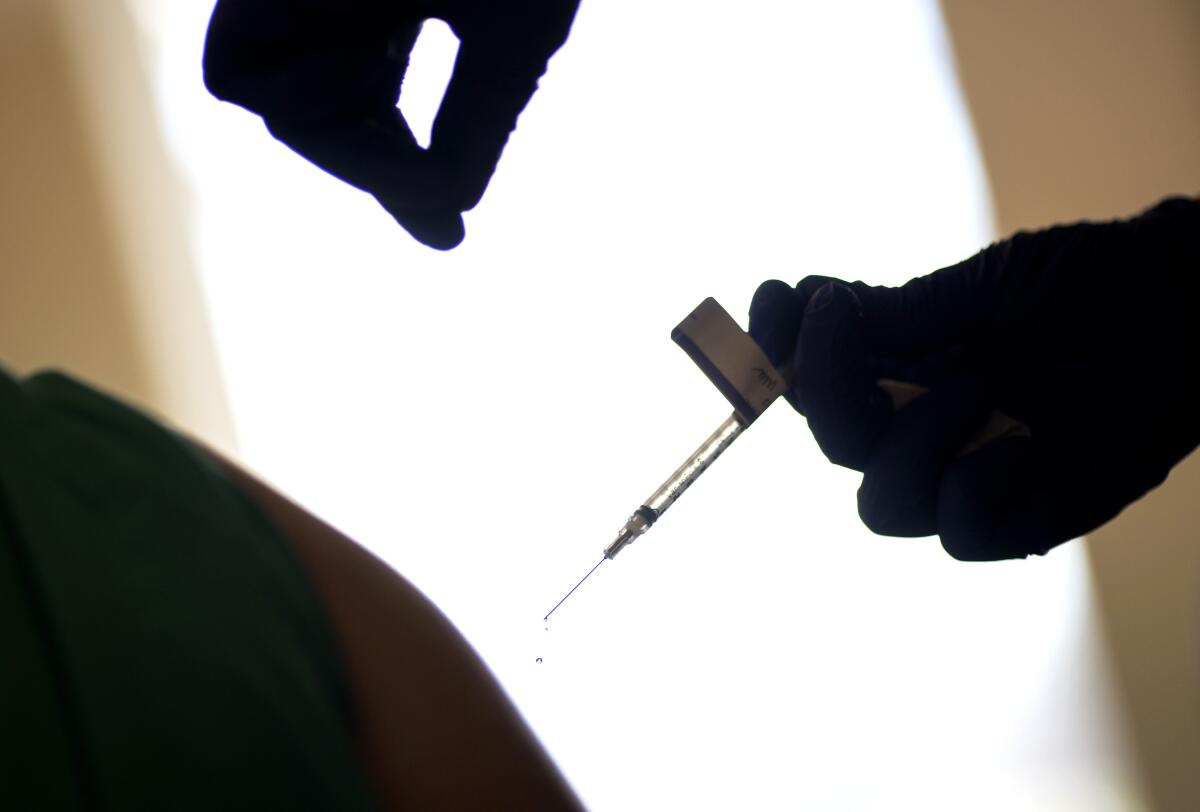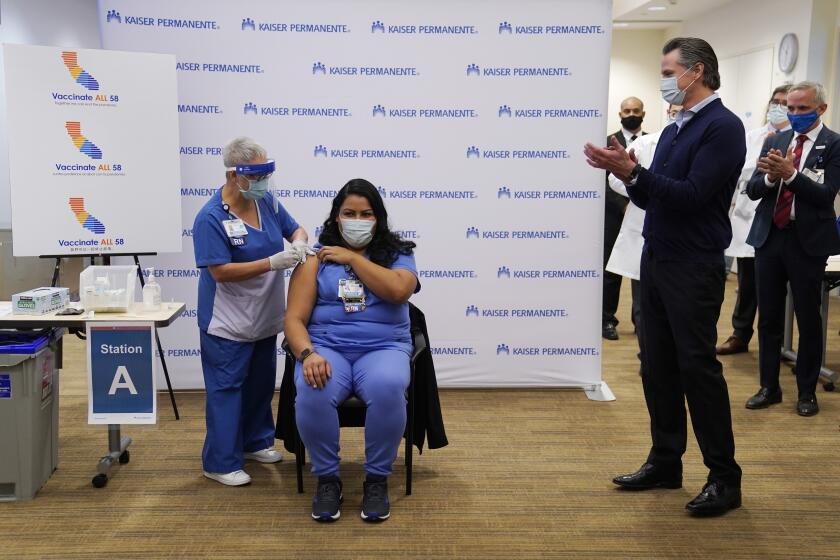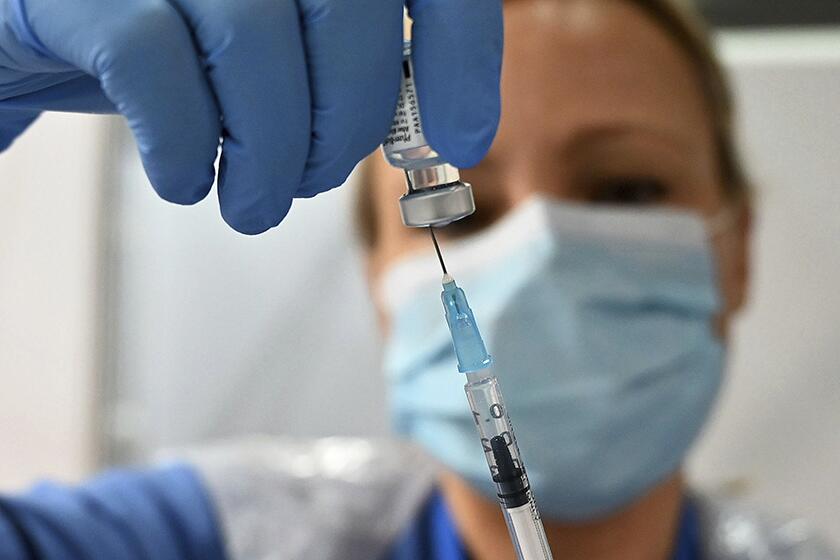Health officials track safety issues as COVID-19 vaccines roll out

- Share via
As COVID-19 vaccinations roll out to more and more people, health authorities are keeping close watch for any unexpected side effects.
On Tuesday, a health worker in Alaska suffered a severe allergic reaction after receiving the Pfizer COVID-19 vaccine. Doctors already knew to be on the lookout after Britain reported two similar cases last week.
In the U.S., vaccine recipients are supposed to hang around after the injection in case signs of an allergy appear and they need immediate treatment — exactly what happened when the health worker in Juneau became flushed and short of breath 10 minutes after the shot.
Allergies are always a question with a new medical product, but monitoring COVID-19 vaccines for any other, unexpected side effects is a bigger challenge than usual. It’s not just because so many people need to be vaccinated over the next year. Never before have so many vaccines made in different ways converged at the same time — and it’s possible that one shot option will come with different side effects than another.
Staffers at the U.S. Food and Drug Administration have conducted scientific reviews of two vaccines — one from Pfizer and BioNTech, the other from Moderna and the National Institutes of Health — and have found no major safety risks.
If the COVID-19 vaccine from Pfizer and BioNTech was good enough to get a nod from the FDA, the vaccine from Moderna and the NIH almost certainly is as well.
But the allergy concern “points out again the importance of real-time safety monitoring,” said Dr. Jesse Goodman of Georgetown University, a former FDA vaccine chief.
And authorities have multiple ways of tracking how people fare as these COVID-19 vaccines — and hopefully additional ones in coming months — get into more arms.
How will I feel after vaccination?
Getting either the Pfizer-BioNTech shot or the Moderna version can cause some temporary discomfort, like many vaccines do.
In addition to a sore arm, people can experience a fever and some flu-like symptoms — fatigue, aches, chills, headache. They last about a day, sometimes bad enough that recipients miss work, and are more common after the second dose and in younger people.
For most people, side effects should be mild and may include flu-like symptoms for a day or two. People with severe allergies should consult a doctor.
These reactions are a sign that the immune system is revving up. COVID-19 vaccines tend to cause more of those reactions than a flu shot, about what people experience with shingles vaccinations. But some of the effects are similar to early coronavirus symptoms, one reason hospitals are staggering when their employees get vaccinated.
What about serious risks?
The FDA found no serious side effects in the tens of thousands enrolled in studies of the two vaccines.
Still, problems so rare they don’t occur in even very large clinical trials sometimes crop up when a vaccine is used more widely and without the stringent rules of a clinical trial.
The first allergy reports from England were in people with a history of serious allergies, and British authorities warned those with severe prior experiences to hold off vaccination until they determine what ingredient might be a problem.
U.S. health authorities are giving more nuanced advice. People always are asked about allergies before vaccinations, and instructions for the Pfizer-BioNTech shot say to avoid it if you’re severely allergic to one of its ingredients or have had a severe reaction to a prior dose. Health workers can go over the ingredient list.
The Centers for Disease Control and Prevention advises people to stick around for 15 minutes after vaccination so they can be treated immediately if they have a reaction. Those with a history of other allergies are asked to stay for 30 minutes.
A lot of things are different when you’re in the midst of a global pandemic. A case in point: How federal regulators scrutinize and authorize new vaccines.
The Alaska health worker, who doctors said had no history of allergies, was following that advice and got prompt care for a particularly severe reaction called anaphylaxis. She has recovered after a night of observation in the hospital — but won’t be allowed a second vaccine dose.
Alaska doctors alerted U.S. authorities, who will continue the monitoring required to tell just how common that kind of reaction really is. That will be especially important as enough vaccine arrives for injections to be given outside of healthcare settings that have lots of experience handling such a reaction.
“Balancing any potential risks with the benefits the vaccine provides in the pandemic is an ongoing process,” Dr. Jay Butler, the CDC’s deputy director for infectious diseases, cautioned Wednesday.
What if other risks crop up?
The challenge is telling whether the vaccine caused a health problem or if it’s coincidence. Don’t jump to conclusions that there’s a connection, health authorities stress.
Researchers look for such connections by comparing any reports of possible side effects with data showing how often that same condition occurs routinely in the population.
When people talk about COVID-19 vaccines, they can sound like they’re speaking a foreign language. Don’t worry! Here’s your guide to vaccine vocabulary.
The government has multiple ways to do that. Doctors are required to report any patient problems. But the FDA is scrutinizing massive databases of insurance claims for early red flags that any health problems are occurring more often among the newly vaccinated than they are in everyone else.
On its list to check is Bell’s palsy, a temporary facial paralysis that occurred in a handful of people in both vaccine studies. The FDA said it’s probably coincidence, but will track the issue to be sure.
Vaccine recipients can help with the extra safety tracking. A program run by the CDC called “ v-safe” automatically sends a daily text for the first week after each vaccine dose to ask how people feel. Weekly texts follow for the next five weeks. Any responses that suggest concern prompt a phone call for further information.










